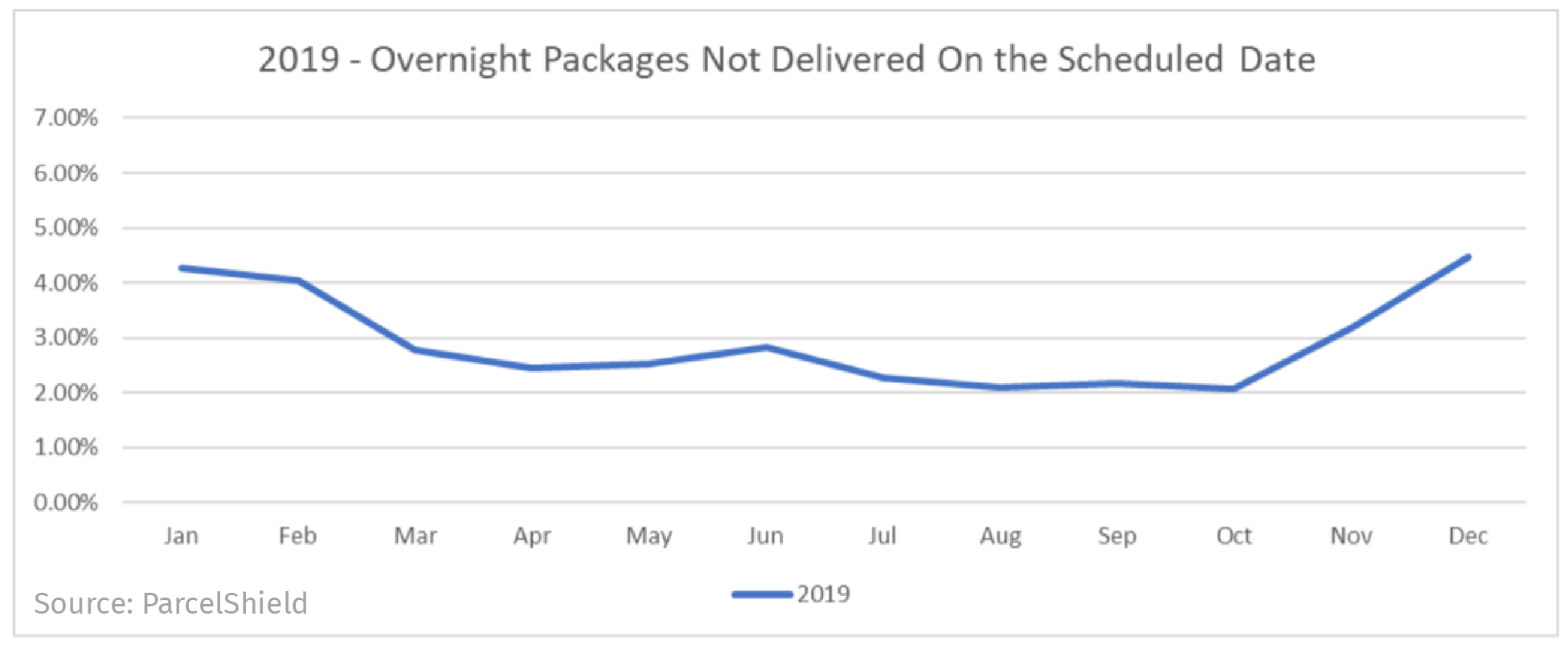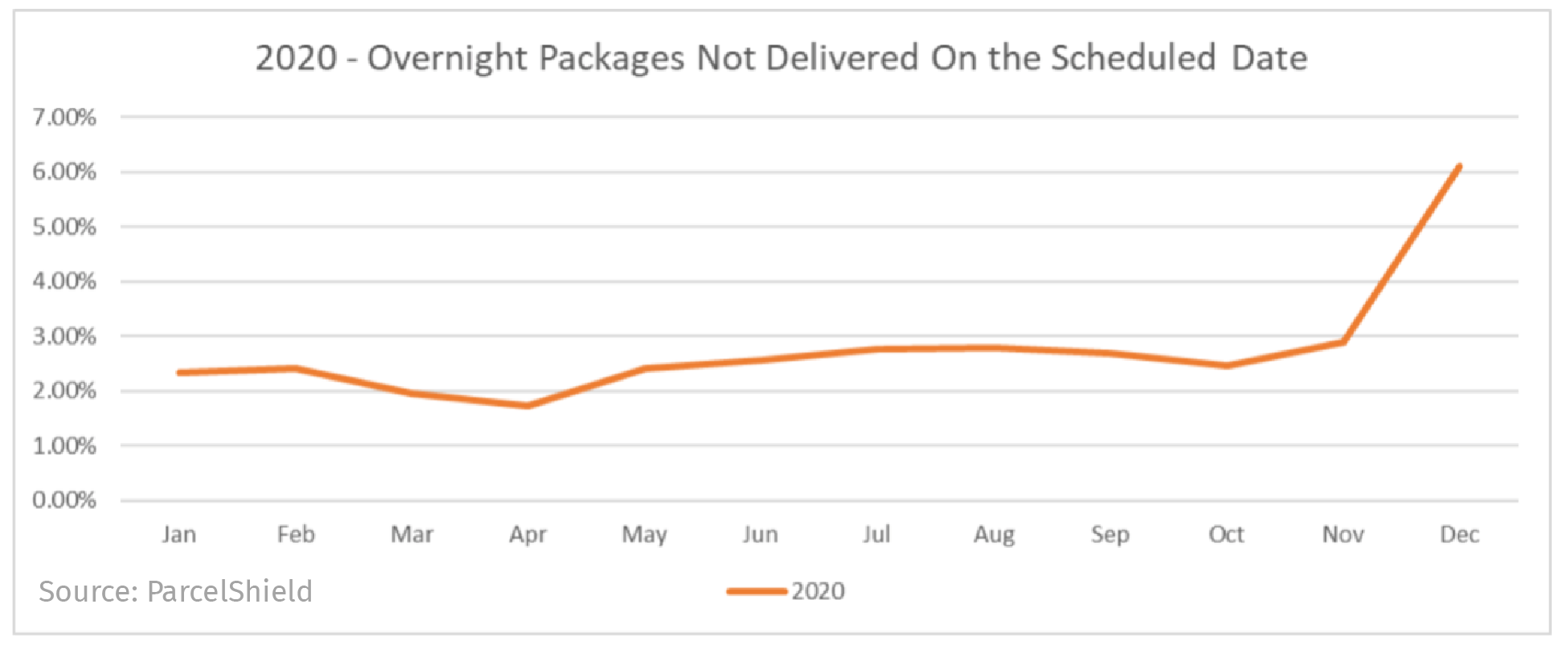Specialty Pharmacies: Use Predictive Analytics Tracking Data to Navigate Carrier Network Congestion This Holiday Season
Carriers are essential, and at times, their delivery-level services are less predictable, which can create challenges for the healthcare industry and to specialty pharmacies and pharmaceutical companies alike. The carrier's ability to deliver prescriptions on schedule is vital to overall patient health while directly impacting patient net promoter scores for specialty pharmacies and medication possession ratios for pharmaceutical companies.
Pharmacies can expect increases in parcel transit times because of widely known fourth-quarter holiday shipping patterns that add to the average parcel volumes. Typically, carriers will suspend service guarantees during this time of the year, relax air commit delivery times, add a day in some ground lanes, and experience regular increases in winter weather events.
Here’s the challenge: Reports abound that carriers face far more delivery challenges this holiday season than in years past. Causes are numerous:
- The pandemic has significantly impacted consumer purchasing behavior. Spending is increasing as the economy reopens. Mastercard reported their Q2 2021 revenue surged 36% over last year, and Visa found that 53% of consumers were spending more in June 2021 than in June 2020. According to reports, online retail sales increased 32.4% year-over-year in 2020 and were up 39% in Q1 2021.
- With accelerated e-commerce growth, the demand for parcel services will only exceed supply. Cyber Monday and holiday shopping continue to increase e-commerce growth, creating enormous demand for parcel shipments in the last few months of the year. Some are reporting demand for peak-season parcel delivery services will outstrip U.S. carrier capacity by almost 5 million parcels a day.
- Carriers are not immune to nationwide and seemingly industry-agnostic staffing shortages. FedEx officials in Portland, Ore., recently cited staffing shortages, causing it to operate at just 65% capacity, as a reason for its long delivery delays will outstrip U.S. carrier capacity by almost 5 million parcels a day.
Leveraging Data, Industry Insights and Analytics to Make Better Business Decisions
Specialty pharmacies and shippers should not release their packages to the national carrier networks and sit passively by, hoping for the best outcome. Instead, they can be active participants from the loading dock to the front door — by using available data and analytics to make better business decisions when it comes to successfully shipping their next patient medication.
Here are two important tips and a few facts we'd like to share. Knowing these can help the specialty pharmacies and the healthcare industry manage through this 2021 peak shipping season.
- Typically, the fourth quarter brings challenges, but pay particular attention to December.
Historically, more packages are not delivered on time in December than in any other month. Some stats to keep in mind:
- According to tracking data, 2.74% of all packages shipped during Q1-Q3 2019 failed to arrive on their scheduled dates. That number jumped to 4.47% in December — a 163% increase compared to all other months in 2019.
|

- December got much worse than last year.
In 2020, missed delivery dates rose from a 2.42% average during Q1-Q3 to 6.10% in December — a whopping 252% increase in missed delivery dates.
|

- Remember that networks behave differently in December.
Most ground delays occur for packages shipped for delivery the week after Thanksgiving (especially early in the week). On the other hand, air delays will often happen for packages shipped for delivery the week of Monday, Dec. 17.
|
- The Northeast region (N.Y., N.J., Penn., and New England) is most susceptible to missing scheduled delivery dates by carriers in December.
When we compared parcel-tracking data across the seven U.S. carrier regions (namely Hawaii-Alaska, Midwest-East, Midwest-West, Northeast, South, Southeast, and West), the following trends were observed:
- The Northeast experienced a 248% increase in missed delivery dates, which is considerably higher than any other region in the country.
- During December 2020, while the total U.S. averaged a 252% increase in parcels not reaching their destinations on schedule, the Northeast skyrocketed by nearly 420%.
- Finally, “overnight” does not necessarily mean “next day,” especially in the Northeast.
We looked at the average number of days it took to deliver overnight packages in the Northeast in 2020. For most of the year, the average number of days was 1.08. In December, it jumped to 1.20 days. By learning to recognize the hidden signs of where and when carrier networks will be the most taxed, specialty pharmacies and shippers can anticipate whatever the holiday peak season throws at them and optimize their on-time delivery dates.
|
By learning to recognize the hidden signs of where and when carrier networks will be the most taxed, specialty pharmacies and shippers can anticipate whatever the holiday peak season throws at them and optimize their on-time delivery dates.
About ParcelShield
ParcelShield provides predictive analytics and support services that reduce the risk for shippers and improve patient or end-user satisfaction. ParcelShield has artificial intelligence and machine learning predictive models that provide real-time, carrier agnostic, deliverability risk-insight to prevent package distress before it happens. And when disruption and distress are unavoidable, ParcelShield deploys support services to track, communicate, and intercept critical packages to close the final mile, reduce loss, and deliver for the patient or end-user. For more information visit www.parcelshield.com.



